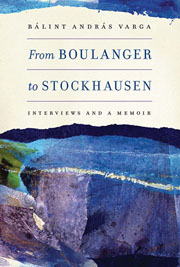Book contents
- Frontmatter
- Dedication
- Contents
- Foreword
- Acknowledgments
- Part One Interviews
- Preface to the Interviews
- Composers
- Conductors
- Instrumentalists
- Singers and a Record Producer
- A Teacher
- Music Administrators
- Snippets
- Claudio Abbado
- Sir Neville Cardus
- Aaron Copland
- Antal Doráti
- Géza Frid
- Sylvia Goldstein
- Ralph Kirkpatrick
- Witold Lutosławski
- Vlado Perlemuter
- Arthur Rubinstein
- György Sándor
- Walter Susskind
- Joseph Szigeti
- Part Two A Memoir
- Notes in Retrospect
- Index
- Miscellaneous Endmatter
Vlado Perlemuter
from Snippets
Published online by Cambridge University Press: 05 January 2014
- Frontmatter
- Dedication
- Contents
- Foreword
- Acknowledgments
- Part One Interviews
- Preface to the Interviews
- Composers
- Conductors
- Instrumentalists
- Singers and a Record Producer
- A Teacher
- Music Administrators
- Snippets
- Claudio Abbado
- Sir Neville Cardus
- Aaron Copland
- Antal Doráti
- Géza Frid
- Sylvia Goldstein
- Ralph Kirkpatrick
- Witold Lutosławski
- Vlado Perlemuter
- Arthur Rubinstein
- György Sándor
- Walter Susskind
- Joseph Szigeti
- Part Two A Memoir
- Notes in Retrospect
- Index
- Miscellaneous Endmatter
Summary
The French pianist—born to a Jewish family in Kowno, Lithuania—played Ravel, Debussy, and Chopin in Budapest in 1968 and 1970. He readily granted me an interview, even though he must have known that I would be asking him about his friend and mentor, Maurice Ravel. If he was tired of having to talk yet again about the composer, he gave no outward sign of it.
I remember his china-blue eyes, the curiously swarthy tan of his skin, the incredibly straight parting in his snow-white hair, and his amazingly high voice. As I translated this interview, I realized I could not recall his piano playing. A brief listen to his recordings provided the explanation. My musical background had not prepared me for the very special idiom of Ravel and Debussy. Their world was foreign to me. Now I cannot but marvel at Perlemuter's artistry. In playing Ravel, he transformed the sound of the piano: he erected an edifice made of crystal and glass, transparent, glittering, cold, devoid of any trace of sentimentality. When he played Chopin, the instrument sang under his fingers. His ritartandi and rallentandi, the carefully placed accents were revelatory in lending the melodies an absolutely unique suppleness; be seemed to he stroking the music. Where virtuosity was called for, it was mastered with bravura. Vlado Perlemuter was a great artist, a great musician.
O
Vlado Perlemuter (VP): I was nineteen or twenty years old when I met Ravel.
- Type
- Chapter
- Information
- From Boulanger to StockhausenInterviews and a Memoir, pp. 253 - 254Publisher: Boydell & BrewerPrint publication year: 2013



